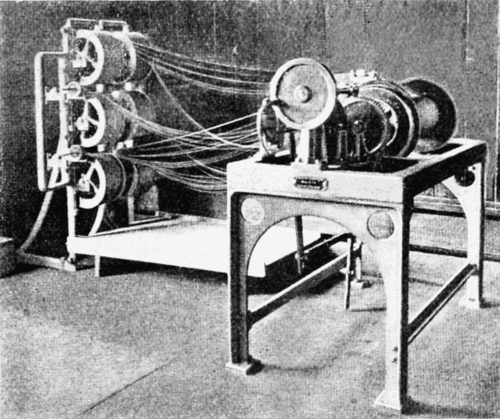ter, which becomes heated to incandescence when an electric current is sent through it. This device is what is known as the naval detonator. Mercury fulminate is so employed because it is the most violent

Blending Machine for Cordite.
of all explosives in common use, and exerts a pressure of forty-eight thousand atmospheres when fired in contact. Although the naval detonator contains but thirty-five grains of mercury fulminate, yet it will rupture stout iron and heavy tin torpedo cases when fired suspended in them, it will rend thick blocks of wood when placed in a hole and fired within them, and it will even pierce holes through plates of the finest wrought iron one-sixteenth inch in thickness if only the base of the detonator is in contact with the plate, and this has been used as a test of their efficiency. Its force is markedly shown by firing one in a stout iron cylinder filled with water and closed tightly, when the cylinder is blown into a shredded sphere. When used to detonate gun cotton, either when confined or in the open, the detonator is placed in the hole which has been molded in the center of the gun-cotton disk or block, so that it shall be in close contact with the gun cotton.  Cartridge of Cordite Smokeless Powder. Charge for 6-inch 2 F gun, 13 pounds, 4 ounces. Cords, 223⁄4 inches long, 3 inches in diameter. I have found that perfectly dry compressed gun cotton is detonated by 2.83 grains of mercury fulminate; but as a torpedo attack is necessarily in the nature of a forlorn hope and should be provided with every possible provision against failure, and since if the detonator fails the attack fails, the naval detonator is supplied with thirty-five grains, so as to give a large coefficient of assurance.
Cartridge of Cordite Smokeless Powder. Charge for 6-inch 2 F gun, 13 pounds, 4 ounces. Cords, 223⁄4 inches long, 3 inches in diameter. I have found that perfectly dry compressed gun cotton is detonated by 2.83 grains of mercury fulminate; but as a torpedo attack is necessarily in the nature of a forlorn hope and should be provided with every possible provision against failure, and since if the detonator fails the attack fails, the naval detonator is supplied with thirty-five grains, so as to give a large coefficient of assurance.
